Locals' Choice! Tono's Best Cherry Blossom Spots 2024

The long winter is over, and we can finally feel the signs of spring. Tono City has many beautiful cherry blossom spots that are loved by locals. This time, we have collected information on cherry blossom spots in Tono City that are loved by locals and that will make you feel the arrival of spring.
Nabekura Park

Nabekura Park, built on the site of the former castle of the Tono Nanbu clan, has long been a famous cherry blossom spot representing Tono, where you can enjoy about 1,000 different kinds of cherry trees, including Somei-yoshino, Ooyamazakura, Edohiganzakura, Washinoo, Goi-ko, Fugenzo, Taishanfukun, and Shogetsu. Every year from late April to early May, the cherry blossoms bloom beautifully throughout the park, and you can get a panoramic view of the city center from the observation deck modeled after the castle tower.
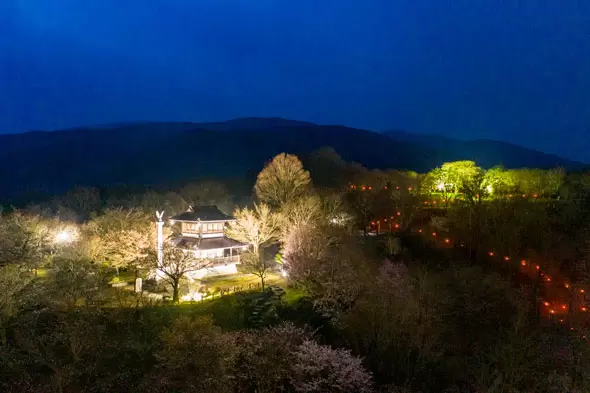
*In 2024, the statue will be lit up from April 13th (Saturday) to May 6th (Monday, national holiday) from evening until 9:00 p.m.
Cherry blossom trees lined with twill
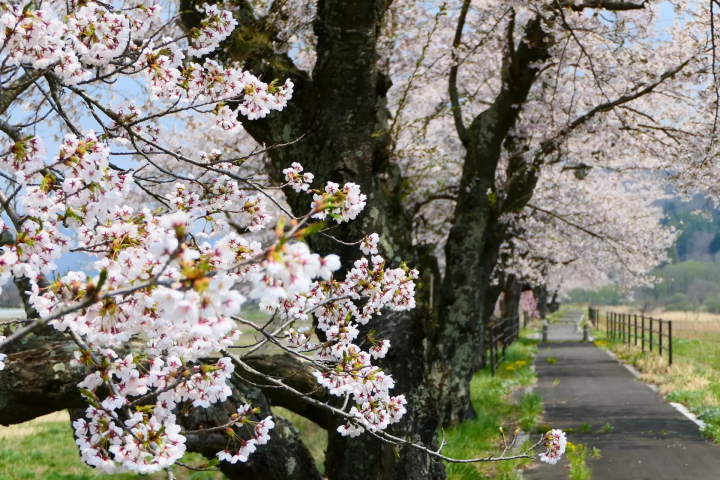
The "Ayaori Cherry Blossom Avenue," a familiar sight that represents spring in Tono City, features over 100 Somei-Yoshino cherry trees that stretch for about 1.2 km along the bicycle-only road between Route 283 and the Sarugaishi River. The view of the Sarugaishi River and Mount Rokkoushi from the row of cherry trees is a sight that represents spring in Tono. We also recommend taking a leisurely bike ride while admiring the cherry blossoms.
There is a roadside station called "Tono Kaze no Oka" nearby, so why not stop by after your shopping trip and take a stroll along the cherry blossom-lined street?
Fukusenji Temple
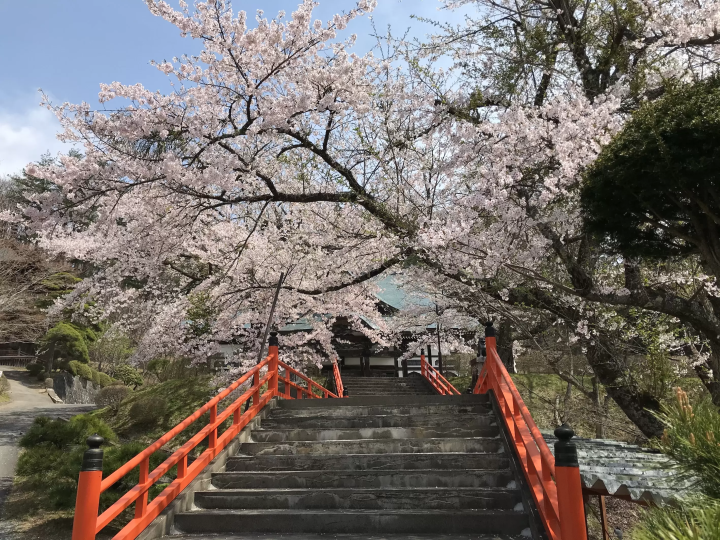
Fukusenji Temple is a Shingon sect temple (its mountain name is Homonzan) that was opened in 1912. It is known for its huge 17-meter tall wooden eleven-faced Kannon statue, one of the largest wooden statues in Japan, but it is also a popular spot for viewing cherry blossoms and azaleas in spring and autumn leaves in autumn, and is always bustling with worshippers enjoying the scenery.
Fukusenji Temple | Tourism Information:::Tono City Tourism Association (tonojikan.jp)
Tono Furusato Village
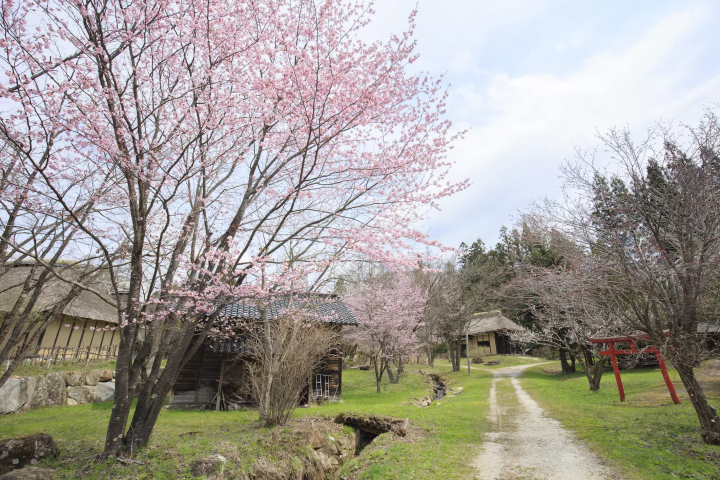
This facility recreates the nostalgic farm village of Tono by relocating and preserving the "Nambu Magariya" houses from the mid-Edo to mid-Meiji periods that were located in Tono City. Instructors called "Maburito" (guardians) are available in the village, and you can actually experience farm work and various aspects of mountain village life. With a stream running through it, a waterwheel turning, and fields, this village gives the impression that the villagers are living there every day, and it is often used as a location for TV dramas and movies.
Experience mountain village life at "Tono Furusato Village" (tono-furusato.jp)
Cherry blossoms and red pines of Mount Dainichi (Hie Shrine)
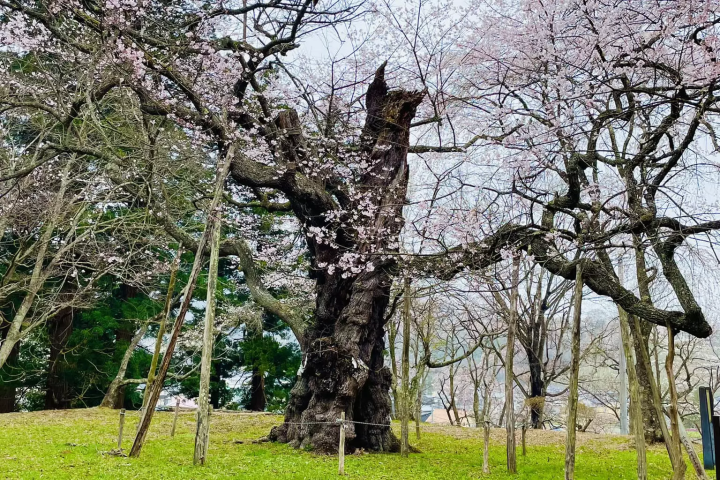
Behind Tono Elementary School, on Mount Dainichi, there is Hie Shrine, which is said to have been founded during the Jogan era (859-877) of the Heian period. Hie Shrine is revered as the main guardian deity of the Tono region and attracts many worshippers. On the side of the shrine grounds, you can see an Edohigan cherry tree that is over 300 years old and a red pine tree that is said to be over 400 years old, both of which have been certified as Tono Heritage Sites. The cherry tree in particular is said to have been planted by Yuinyo Hoin, the head priest of Zennoji Temple, when he invited a branch of the spirit of Mount Yudono to be enshrined at the request of Lord Nanbu Yoshinaga in the spring of 1685 (the second year of the Jokyo era) and built the Dainichi Hall on the grounds.
The grounds of Motohachimangu Shrine and the Couple Sugizakura
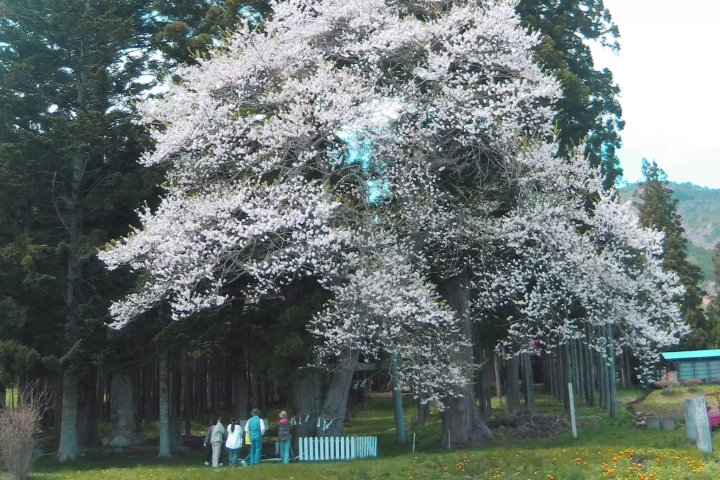
This is where the Hachiman Shrine currently located in Shiraiwa, Matsuzaki Town, used to be. For a time, Moto-Hachiman Shrine fell into disrepair, but was restored after the Meiji period, and a new main hall and worship hall were built in the early Taisho period, and it is now called Moto-Hachiman. Within this shrine grounds, there is a famous "Couple Sugizakura" (Couple Sugizakura), a married couple of cedar and cherry trees that have grown over the years, embracing each other at the base and intertwining their roots to resemble a married couple. This "Couple Sugizakura" tree, which has also been designated a Tono Heritage Site, blooms beautifully in the spring.
Weeping cherry tree at Kisei-in Temple
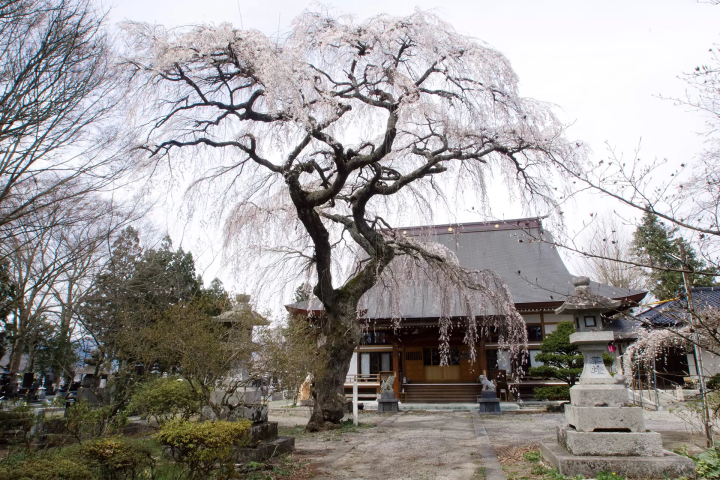
In 1720, the 6th head priest Tsunemoto planted a weeping cherry tree given to him by the Nanbu family in front of the temple. However, the tree was destroyed in a fire in 1891. A new tree was grown from the seed of the surviving weeping cherry tree, and it is the cherry tree we see today. Tsunemoto was originally a sandal bearer for the Nanbu family, but became a monk after the death of the feudal lord. He later became the head priest of Kisei-in Temple and visited the Nanbu family in memory of the deceased, offering incense at their grave and offering prayers. It is said that on his way home from the prayer service, he was given a cherry tree, which he planted next to the grave. In 1983, the tree was designated a city designated natural monument, and is also certified as a Tono Heritage Site.
Certification number 121: Weeping cherry tree at Kisei-in Temple - Tono City (city.tono.iwate.jp)
Cherry blossom trees along the Sarugaishi River in Kamimasuzawa
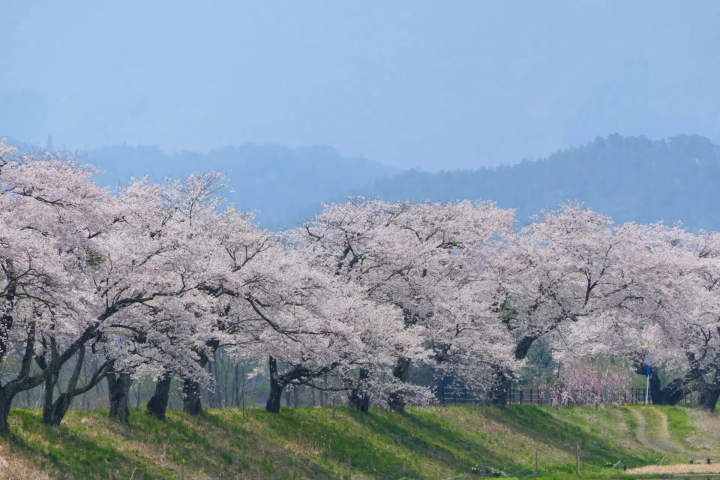
The 1.5km long cherry blossom avenue on both sides of the Sarugaishi River, which runs along National Route 283 in Masuzawa, Tono Miyamori Town, is a famous cherry blossom spot beloved by local people. The Sarugaishi River basin suffered severe damage from Typhoon Kathleen in 1947 and Typhoon Ion the following year in 1948, and embankments were constructed on both sides. To commemorate the completion of the embankment, in 1953, local veterinary scholar and professor at Morioka Higher Agricultural and Forestry School (the predecessor to the Faculty of Agriculture at Iwate University), Mr. Kenjiro Kikuchi, donated some Somei-Yoshino cherry tree seedlings. They were planted by the local youth association. Since then, the local people of Kamimasuzawa have been carefully protecting them for over 70 years. This "Sarugaishi River Cherry Blossom Avenue in Kamimasuzawa" has also been designated as a Tono Heritage Site.
Yamazakura at Tsuchibuchidaibora
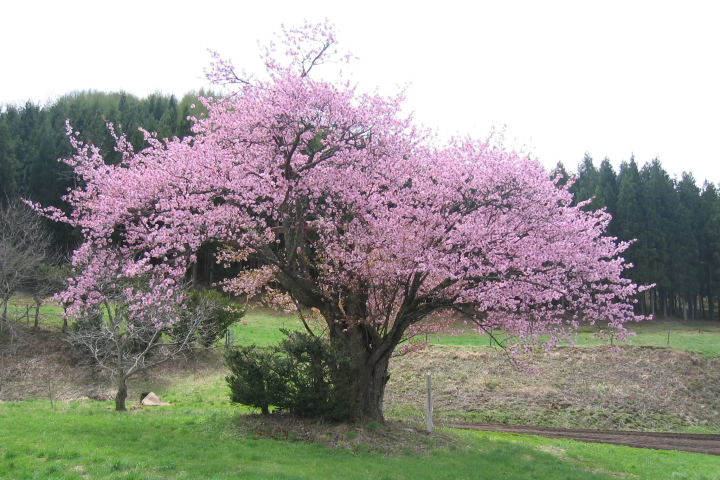
This old mountain cherry tree, known as "Oobora no Ipponzakura" (Oobora's single cherry tree), is designated as a natural monument in Tono City. The exact age of this cherry tree is unknown, but it is said to have a history of over 300 years. It is located near "Dannohana" and "Denderano" that appear in the famous "Tono Monogatari", and is loved by local residents as a symbol of the Yamaguchi area of Tsuchibuchi Town. However, at one point, the trunk began to rot and the cherry tree was severely damaged. In 2014, tree doctor Takamura Naotake treated the tree with the cooperation of local residents, and the tree has made a wonderful recovery. Yamazakura is known for its deep color and still retains a beauty that is different from Somei Yoshino. In June 1981, it was designated as a natural monument of Tono City.
Tono City is not only beautiful, but also has many historical spots, including many spots that appear in the "Tono Monogatari" (The Tales of Tono). However, some locations are not well-maintained, such as lacking parking lots. Please respect local rules and the environment, and cooperate so that everyone can enjoy the cherry blossoms.
We are a regional trading company responsible for promoting local products and revitalizing tourism in Tono City, Iwate Prefecture. Tono is home to numerous legends about kappa and zashiki warashi, and is also home to an abundance of agricultural and livestock products that take advantage of its location in a basin, with one of the largest production volumes of hops used in beer in Japan. I'm proud. By interweaving Tono's people, goods, history and culture, we aim to create value unique to the region, refine the Tono brand, and revitalize the region.
The contents on this page may partially contain automatic translation.





























![[Coupon Available] Attention Overseas Winter Sports Fans! Nagano's Sports Depot Has Evolved](https://resources.matcha-jp.com/resize/720x2000/2026/01/05-254819.webp)
![[2 hours from Tokyo ] 10 Quiet and Breathtaking Views of Mount Fuji in Yamanashi Hokuto City , Yamanashi - Part 2](https://resources.matcha-jp.com/resize/720x2000/2025/12/16-253037.webp)

![[Reopening in March 2026] Ikoma Sanjo Amusement Park Park, 45 minutes from Osaka , with free admission](https://resources.matcha-jp.com/resize/720x2000/2024/08/28-194409.webp)